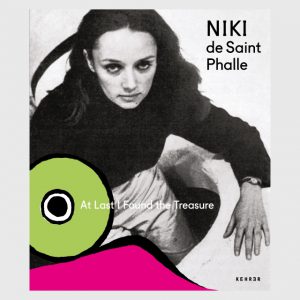©2016 Kehrer Verlag Heidelberg Berlin, Kunst- und Kulturstiftung Opelvillen Rüsselsheim and authors [and translators!]
All chapters (apart from The Theatrical Collaborations of Kenneth Koch, Niki de Saint Phalle and Jean Tinguely, by Gerard Forde) translated from German into English by Alexandra Cox
From the Preface of this catalogue accompanying the exhibition of the same name at the Kunst- und Kulturstiftung Opelvillen Rüsselsheim, December 2016-March 2017:
The chronological density of Niki de Saint Phalle’s theatre works in the 1960s corresponds to the changes in the visual and performing arts during this decade. Whereas, in the 1950s, there were barely any visual artists working for the theatre, the situation changed in the course of the 1960s, when theatre was integrated into art, and likewise art into theatre. Genre boundaries began to dissolve and interdisciplinary methods were increasingly being developed and established. For visual artists, this process became more important than creating a definitive art object. Happenings and environments consequently defined the avant-garde; provocative events turned against the elite character of art, and actionist progressive forms propagated the abolition of the ‘art and life’ divide. The shooting actions of Niki de Saint Phalle, which she began in 1961, are to be regarded in this context. The artist herself not only shot at pictorial works equipped with liquid paint, but also invited her audience to play an active role in this. That she was not obliged to be present for this in person is demonstrated by a Nouveau Réalisme exhibition, Daniel Spoerri’s Der Koffer (The Suitcase) in Cologne, with which he introduced the group for the first time in Germany on the evening of 10 June 1961: ‘Some 200 spectators had already gathered (among them David Tudor). Although I had been asked not to stretch out my number for more than 10 minutes, in the end, I think, it lasted one and a half hours. First I had to saw open the lock, then I distributed sweets from Niki. Tinguely had ordered a soap-bubble performance, while Gherasim Luca had had a poem printed for handing out, and Dufrêne had screamed a few scraps of his sound poems on tape. One had the opportunity to shoot at a picture of Niki de Saint Phalle, then two Tinguely sculptures had to be mounted (they were secured on the basket), and so on, and so forth.’ These new presentations of art as a form of action entailed concrete borrowings from the theatre, such as the introduction of scenic associations, stage-like spaces, and props. The resulting actions all had one goal: to approximate reality and, as a result of new structures of perception, to herald in a more critical environmental, societal, and artistic consciousness.
There has been no research, thus far, into the role that Niki de Saint Phalle assumed in this process. The exhibition At Last I Found the Treasure – Niki de Saint Phalle and the Theatre was conceived in order, for the first time, to present the artist, with more than a hundred objects, models, screen prints, and posters, as a significant force for performative art and theatre in the 1960s. At the same time, this museum presentation highlights the significance of de Saint Phalle in the interpenetration of art and theatre. The impetus she provided, in order to bring art and audience together in a new way, are* highlighted in the present publication for the first time. De Saint Phalle’s common characteristic with the creative personalities of the New York avant-garde, the Nouveaux Réalistes in Paris, and the theatre pioneers in Ulm and Kassel in the 1960s was the desire to provide art with manifold opportunities.
*The existence of the plural of “impetus” (impetuses) was disputed. This error is the result.
Disclaimer: “I had a serious depression”* (page 9), “a bottle that sinks into the floor unharmed”** (page 188) and “Aftermaths”*** (page 189) are changes made by a third party before the translations went to print.
* “a depression”: in the case of the illness, the noun is not countable (in British English, at least — which applied to this assignment).
** “an unharmed bottle”: this is like saying an “eine unverletzte Flasche” or “une bouteille non blessée”. Of course the word should be “intact” or “unbroken”.
*** “Aftermaths”: these are the consequences of something very negative, a war, for example. (I had written “Afterwards” as the paragraph title.)
Further extracts from Niki de Saint Phalle: At Last I Found the Treasure:
More Niki de Saint Phalle: Variations II: Homage to David Tudor 1961, by Beate Kemfert
